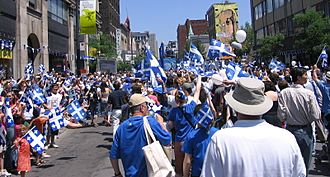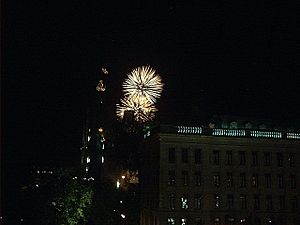Saint-Jean-Baptiste Day facts for kids
Quick facts for kids Saint-Jean-Baptiste Day |
|
|---|---|

Saint-Jean-Baptiste parade, Montreal, June 24, 2006
|
|
| Also called | Fête de la Saint-Jean-Baptiste, St John the Baptist Day, La Saint-Jean, Fête nationale, National Holiday |
| Observed by | Quebecers, French Canadians, French Americans/French Canadian Americans |
| Type | Historical, cultural, national, religious |
| Celebrations | Parades, bonfires, fireworks, feasting, drinking, musical concerts, flag waving, patriotic speeches, contests |
| Date | June 24 |
| Next time | June 24, 2026 |
| Frequency | annual |
Saint-Jean-Baptiste Day (French: Fête de la Saint-Jean-Baptiste, la Saint-Jean, Fête nationale du Québec), also known as St John the Baptist Day, is a special holiday. It is celebrated on June 24 in Quebec, a Canadian province. French Canadians across Canada and the United States also celebrate it. French settlers brought this tradition to Canada. They were celebrating the traditional Christian feast day of the birth of Saint John the Baptist. In 1925, it became a public holiday in Quebec. The government helps organize events for everyone to enjoy.
History of the Celebration
The feast day of Saint John the Baptist was very popular in old France. It is still celebrated as a religious holiday in many countries. These include Denmark, Norway, Sweden, and Spain.
The tradition came to Canada with the first French colonists. The first time Saint-Jean-Baptiste celebrations were mentioned in North America was in 1606. Settlers on their way to Acadia rested in Newfoundland on June 23. Another mention of celebrations happened on the Saint Lawrence River in 1636. People lit a bonfire and fired cannons.
In Lower Canada (which is now southern Quebec), the celebration of Saint John the Baptist's birth became more patriotic in 1834. This happened because of Ludger Duvernay. He was one of the founders of a newspaper called La Minerve. Duvernay and other "patriotes" saw how the Irish diaspora celebrated Saint Patrick's Day in Montreal. This gave them the idea to create a similar celebration for all French Canadians and their friends.
On June 24, 1834, a famous song was sung for the first time. It was George-Étienne Cartier's "Ô Canada! mon pays, mes amours". This happened at a big patriotic dinner in Montreal. About sixty French and English-speaking people attended. The "Canada" in the song meant Lower Canada. People made toasts to the Parti patriote and other groups.
Two days later, the La Minerve newspaper said this holiday would help unite French Canadians. It predicted it would be celebrated every year as a national holiday. The celebration continued in 1835, 1836, and 1837.
After some troubles and military actions, the holiday was not celebrated for several years.
In 1834, Duvernay started the Saint-Jean-Baptiste Association. Its goal was to celebrate Saint-Jean-Baptiste Day that year. The association officially became a group in 1849. Its mission was to help society improve. (You can learn more about the Saint-Jean-Baptiste Society.)
The Catholic Church supported the celebrations. At that time, they were mostly religious. People still lit bonfires at night. This was a very old custom for Saint John's Day. The first Saint-Jean-Baptiste parades also began. These parades became a very important tradition. Floats with special designs were added to the parades in 1874.
On June 24, 1880, the Saint-Jean-Baptiste Society brought together all French-speaking communities in North America. This was the first National Congress of French Canadians. In Quebec City, people first heard the song "Ô Canada". Calixa Lavallée wrote the music. A judge named Adolphe-Basile Routhier wrote the poem. The Saint-Jean-Baptiste Society asked for this song to be created. People liked it, but it took many years for it to become well-known. English words were added later for a royal visit in 1901. In 1980, "O Canada" became Canada's official national anthem.
In 1908, Pope Pius X named St. John the Baptist the special protector of French Canadians. From 1914 to 1923, the parades did not happen. In 1925, June 24 officially became a legal holiday in Quebec.
The Fête nationale (National Holiday)
In Quebec, June 24 is officially a paid public holiday. It is called the Provincial Holiday. In 1977, the Lieutenant Governor of Quebec, Hugues Lapointe, declared June 24 the provincial holiday. This was done on the advice of Quebec's Premier, René Lévesque.
The next year, the National Holiday Organizing Committee was created. This committee helps plan the events. In 1984, the organization of the celebrations was given to the Mouvement national des Québécoises et des Québécois (MNQ).
By making it a public holiday, the day became a holiday for all Quebecers. It was not just for those of French-Canadian or Catholic backgrounds. The celebrations slowly became less religious. This was mainly due to the MNQ's efforts. June 23 and 24 are now celebrated as they are today. Many parties and events happen on the night before the holiday.
Even though the religious meaning of the public celebration has faded, people still call the day la St-Jean-Baptiste or la St-Jean. Churches still observe it too.
In 2010 and 2011, a politician named Claude Gravelle tried to make Saint-Jean-Baptiste Day a federal holiday in Canada.




